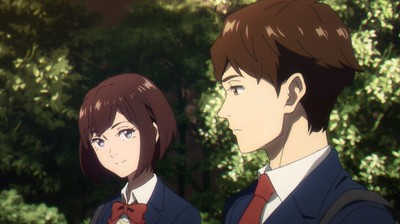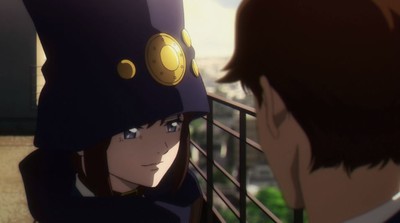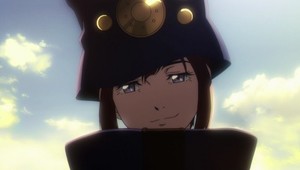The Winter 2019 Anime Preview Guide
Boogiepop and Others
How would you rate episode 1 of
Boogiepop and Others (TV 2019) ?
Community score: 3.6
How would you rate episode 2 of
Boogiepop and Others (TV 2019) ?
Community score: 3.8
What is this?
 In a certain city, there's an urban legend about a strange being known only as “Boogiepop.” Some versions say they're a killer, murdering girls at the height of their beauty so that it will never fade. Others are less certain – and Takeda is one of them because he's met Boogiepop, inhabiting the body of his girlfriend Miyashita. Miyashita's unaware that she's Boogiepop, but that's not the only strange thing going on at their school, because there absolutely is a supernatural force out there killing girls. Between Boogiepop, Echoes (a lifeform sent to determine the inherent worth of humans), Manticore, and the humans investigating, urban legends are proving to be much more dangerous these days. Boogiepop and Others is based on a light novel series and streams on Crunchyroll, Fridays at 9:00 AM EST.
In a certain city, there's an urban legend about a strange being known only as “Boogiepop.” Some versions say they're a killer, murdering girls at the height of their beauty so that it will never fade. Others are less certain – and Takeda is one of them because he's met Boogiepop, inhabiting the body of his girlfriend Miyashita. Miyashita's unaware that she's Boogiepop, but that's not the only strange thing going on at their school, because there absolutely is a supernatural force out there killing girls. Between Boogiepop, Echoes (a lifeform sent to determine the inherent worth of humans), Manticore, and the humans investigating, urban legends are proving to be much more dangerous these days. Boogiepop and Others is based on a light novel series and streams on Crunchyroll, Fridays at 9:00 AM EST.
How was the first episode?
 James Beckett
James Beckett
Rating:
I've never read the Boogiepop novels that have been made available in English, nor have I seen the older Boogiepop Phantom anime from back in the day. All I knew about Boogiepop and Others when I sat down to watch its two-episode premiere was that the book series is considered one of the seminal works of the YA light-novel boom, and that it was supposed to be a little spooky. I was expecting something more in the vein of the Monogatari series, and while I can definitely see the influences that NisiOisin may have taken for his own stories, I was pleasantly surprised to find that Boogiepop and Others reminded me more of Paranoia Agent than anything else.
The first episode is almost obtuse to a fault. The disaffected Keiji discovers that his close friend Touka Miyashita has developed something like a “split personality”; when disturbances arise, Touka takes on the name “Boogiepop”, dons a coat and a big pipe-shaped hat, and goes about using vaguely supernatural abilities to take care of the problem. Boogiepop declares that there is a so-called “maneater” at Touka and Keiji's school and vows to destroy it. Then, after some ennui-driven philosophizing with Keiji on the school roof, Boogiepop tells Keiji that the problem has been solved and promptly gives Touka her body back. End of episode.
It's in the second episode that the scope and nature of the conflict become clearer, and the undercurrent of dread and malice begins bubbling up to the surface. The plot itself is somewhat overcomplicated for my tastes – the episode introduces us to a flesh-eating shapeshifter known as Manticore and the sociopathic boy who develops a relationship with them, then doubles back to show us that the monster is being hunted by another student-turned-superhero named Nagi. Then we're shown that Manticore is somehow linked to an alien named Echoes, who Boogiepop met in the first episode, and by the time the credits rolled I couldn't help but feel that the script could have been tighter on this one.
But what the story lacks in comprehensiveness, it makes up for with pure atmosphere. The Paranoia Agent comparison comes with the almost oppressive sense of uncanniness that permeates this story, which ends up giving the show that fairy-tale quality where adults in the world might as well not exist, and the kids are stuck surrounded by monsters, knowing in their gut that something is wrong without being able to do much about it. While the animation itself is inconsistent, the cinematography and tight storyboarding keep things moving well enough that it's difficult to be too distracted by it. Kensuke Ushio's score is top-notch too, eerie and propulsive in all the right places. This is the odd kind of premiere that I ended up really digging, even though these initial plots and characters left me colder than I'd prefer. On the pure strength of its atmosphere and potential, I'm looking forward to seeing where this show goes this season.
 Nick Creamer
Nick Creamer
Rating:
Boogiepop and Others was one of the big shows on my radar coming into this season, though I admittedly knew the franchise more by reputation than personal experience. I was aware of the generally esteemed Boogiepop Phantom adaptation from some years back, as well as the fact that that prior adaptation was more an exploration of the original work's setting than a direct retelling of its story. I also knew that director Shingo Natsume would be carrying over a number of his close associates from One Punch Man's first season, meaning we had a very noteworthy mixture of lauded source material and strong adaptation team. So for all that, how does Boogiepop's first two episodes play out?
Well, at the very least, I can say this show is pursuing a very specific and fairly unique tone. Washed out colors and saturated lighting present an alienating vision of the modern world, with Boogiepop's distinctively realistic backgrounds creating a strong sense of physical immediacy. Characters move slowly and with ominous purpose in this place, and the music restrains itself to an effective mix of percussion-heavy tone tracks. From its distinctive use of light and color to its generally understated designs and languid pacing, every element of Boogiepop's production is aiming in the same direction, all dedicated to creating a Paranoia Agent-esque sense of urban unease.
Unfortunately, the actual story being conveyed through that tone just isn't terribly compelling so far. While I can appreciate slow-burning dramas, Boogiepop more often comes off as painfully lethargic. The titular Boogiepop talks so slowly and circuitously that I found myself getting tired of them within the first episode, and many scenes in these episodes felt oddly stilted in terms of their moment-to-moment pacing. When you couple that with the show's unfocused narrative structure, often unconvincing dialogue, and generally stiff character animation, you end up with a show that proceeds at a perpetual shuffle, unspooling its mysteries too clumsily and slowly to inspire much interest.
Speaking of mysteries, Boogiepop and Others' greatest issue so far might be its insistence on the mystery as its own reward. There's lots of mysterious stuff happening in this series, but we're not really given an emotional entrypoint to care about any of it - the characters are too vaguely drawn for that, seemingly composed more as vehicles for the mystery than people in their own right. Personally, I don't really care about uncovering things I don't know just because I don't know them; I am perfectly happy not knowing all sorts of things, and need more motivation to invest in a mystery than its mere existence. Without a strong emotional entry point or hook beyond “it's getting pretty spooky in here,” I can't really match Boogiepop's investment in its own story.
Boogiepop and Others gains a bit more energy in its second episode, and its control of atmosphere is fairly compelling, but that's unfortunately not enough to elevate a slow, awkwardly plotted, and emotionally inert pair of episodes. Perhaps this is all building to something greater, but I can't imagine I'll be sticking around to find out.
 Rebecca Silverman
Rebecca Silverman
Rating:
One of the most difficult things about adapting Kohei Kadono's 1998 mystery/science fiction novel has to be the fact that it's written with each chapter in the head of a different person. That means that each character only has one portion of the overall story, with Kirima Nagi in her role as the girl detective (but way cooler than Nancy Drew ever was) wandering through trying to put things together. That things don't come together for a good long time in the book may make this a more frustrating viewing experience than it strictly needs to be, although in all fairness the series may be using these two episodes as set up before deviating a bit pacing-wise from the source material. Regardless, episodes one and two do feel glacially paced for the most part, filled with more slow walking than I've seen since Fate/Zero's opening salvo.
The show is doing a better job by episode two, which is the stronger of the episodes. The first episode introduces us to Boogiepop themselves, while offering glimpses of a much more interesting story involving murdered schoolgirls. The story in this episode is largely expository, with Boogiepop giving Takeda a brief overview of their existence and how Miyashita is unaware of their presence before announcing that the problem they were sent to the school to solve has been resolved and vanishing. It's an episode that feels like it will be much more interesting in hindsight, like you'd want to go back and rewatch it after finishing the rest of the series.
Episode two, on the other hand, tones down the everyday and begins to delve into the more interesting aspects of the story. We truly meet Kirima, the detective figure, and begin to get an idea that there's a lot more going on than the merely supernatural – drugs play a prominent role in whatever's up as a way for both supernatural activities to be concealed and also as a plain old real-world problem. The fate of humanity still seems to be a key factor, with Kirima and Saotome, who is actively helping one of the monsters, functioning as the embodiment of both sides of the argument; the fact that Saotome's “monster” seems to feel decidedly human emotions such as love and fear may also be a significant factor in the show's endgame as well. Themes of man's inhumanity to man are beginning to rear their heads, and if the pacing can balance itself out here, we may be looking at an interesting philosophical mystery show.
The other way this could go is that it could get too wrapped up in being edgy. That's a fine line the novels skirt, and I'm definitely worried that this will go the same way. If you can get through the slow, dragging pace and the fairly uneven art of these two episodes, it may turn out to be worthwhile. At this point, however, I'm more inclined to suggest picking up Seven Seas' recent omnibus release of the books.
 Theron Martin
Theron Martin
Rating:
2000's Boogiepop Phantom (hereafter BP) was one of those rare anime series that didn't much resemble anything that came before or since. Its structural oddities, philosophical musings, and examination of teen angst set against the backdrop of monstrous people and events made it a cult sensation at the time, but that was now a full generation ago. So resurrecting the franchise now by adapting the original novels may seem like an odd choice given that the franchise's 22nd novel was published just last year. Still, I welcome it, as the result is a decided step away from the anime norm.
The first thing that should be made clear is that familiarity with BP is not necessary to understand this series; in fact, this series is the origin story for how things came to be in BP, so going back and watching 2000's Phantom after this one wraps is the best viewing order. The second thing that should be made clear is that this is a horror story at heart, although it doesn't embrace that role completely. This is a story where generally sedate content can be punctuated by shocking bursts of intense graphic violence and imagery. Unlike most graphic anime, the camera never lingers on such content – most scenes are barely more than a flash or implied through creative use of sound effects rather than shown – but if you don't have a stomach for dismembered bodies or cannibalism, then this may not be the series for you.
Actually, “sedate” may not be the right word for the story's calmer moments, because this is not the kind of fare you can watch casually. The perspective sharply shifts from the first to the second episode, which is split between two new perspectives, and the time frame jumps around a lot. There's even an implication that episode 1 may actually encompass the entirety of the story's timeline, but that also might not be the case because this episode only shows things from the perspective of Touka's boyfriend. So get used to this kind of disorientation quickly if you decide to stick with the series. From a monster who assumes human form by completely consuming their victim to multiple personalities to copious murder and drug use, it all sounds like a sensational light novel on paper, but in execution it all melds into an involved narrative that focuses on the anxieties and stress factors on teens as they find their place in the world.
Then there's Boogiepop himself. Although Touka, the character underlying Boogiepop, is a girl, his persona tends to be considered male, and he switches between masculine and feminine manners of speaking. Is Boogiepop actually a supernatural force manifesting in Touka, or is he Touka's true alter ego? He does seem to have supernatural movement capabilities, but that doesn't really clarify much yet.
The technical effort by Madhouse is a strong one, with its most distinguishing feature being the more realistic-looking character designs; you won't find any outlandish clothing or hairstyles here. The music isn't as strong and the quirky construction is just rough enough that I can't give this debut the highest score, but this was my most anticipated debut of the season, and it definitely doesn't disappoint.
discuss this in the forum (621 posts) |
this article has been modified since it was originally posted; see change history
back to The Winter 2019 Anime Preview Guide
Season Preview Guide homepage / archives